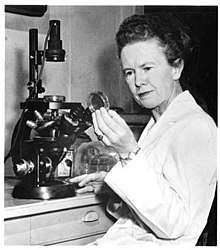Hattie Alexander
| Hattie Alexander | |
|---|---|
 | |
| Born |
April 5, 1901 Baltimore, Maryland |
| Died |
June 24, 1968 (aged 67) New York City |
| Alma mater |
Goucher College (BA) Johns Hopkins University (MD) |
| Known for | Haemophilus influenzae, antibiotic resistance |
| Awards | E. Mead Johnson Award (1943) |
| Scientific career | |
| Fields | pediatrician and microbiologist |
Hattie Elizabeth Alexander (April 5, 1901 – June 24, 1968) was an American pediatrician and microbiologist. She is known for her development of the first effective remedies for Haemophilus influenzae infection,[1] as well as being one of the first scientists to identify and study antibiotic resistance.
Early life and education
Alexander was born in Baltimore, Maryland, and graduated from Goucher College in 1923. She worked for the United States Public Health Service and the Maryland Public Health Service, and then enrolled at Johns Hopkins University medical school, where she received her M.D. in 1930.
Career
In 1932, she became an instructor and researcher in the Department of Pediatrics at Columbia University, where she spent her entire professional career.
In the early 1940s, Alexander began researching Haemophilus influenzae (Hib), at the time an almost invariably fatal disease in infants and young children. From 1941-1945 she served as a consultant to Secretary of War, Henry L. Stimson on the Influenza Commission. She developed an improved antiserum for the disease; by combining antiserum therapy with the use of sulfa drugs, and developing standardized techniques for diagnosis and treatment, she and her associate Grace Leidy helped reduce the mortality rate from Hib from nearly 100 percent to less than 25 percent. Later, Alexander and Leidy studied the effect of antibiotics on Hib, finding streptomycin to be highly effective. The combined use of the antiserum, sulfa drugs, and antibiotics significantly lowered the mortality rate from Hib.
In the course of her research on antibiotics, Alexander noted and reported the appearance of antibiotic-resistant strains of Hib. She concluded, correctly, that this was caused by random genetic mutations in DNA which were positively selected through evolution; she and Leidy demonstrated the occurrence of transformation in the Hib bacillus, leading to resistance.
Awards and honors
Alexander received numerous honors and awards for her work, including the E. Mead Johnson Award (1942), the Elizabeth Blackwell Award (1956), and the Oscar B. Hunter Memorial Award (1962). In 1964, she was elected president of the American Pediatric Society. She was the first women to be elected to this position.[2]
Personal life
She died of liver cancer in New York City in 1968.
References
- ↑ Alexander, HE; Leidy, G (1946), "Influence of Streptomycin on Type b Haemophilus influenzae.", Science (published Aug 2, 1946), 104 (2692): 101–102, doi:10.1126/science.104.2692.101, PMID 17790172
- ↑ Zierdt-Warshaw, Linda; Winkler, Alan; Bernstein, Leonard, eds. (2000). "Alexander, Hattie Elizabeth (1901-1968)". American Women in Technology. Santa Barbara, California: ABC-CLIO. pp. 6–7. ISBN 1-57607-072-7.
Sources
Further reading
- Aydelotte, Allison (2000). Alexander, Hattie Elizabeth (1901-1968), microbiologist and pediatrician. American National Biography.
- Haag, John (1999). "Alexander, Hattie". In Commire, Anne. Women in World History: A biographical encyclopedia. 1. Waterford, CT: Yorkin Publications, Gale Group. pp. 201–202. ISBN 0787640808.
- Shearer, Benjamin F. (1996). Notable women in the life sciences : a biographical dictionary (1. publ. ed.). Westport, Conn. [u.a.]: Greenwood Press. ISBN 9780313293023.